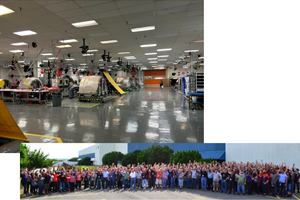Composites: Past, Present and Future: Marine Composites Training and Education, Part III
In Parts 1 and 2, Andre Cocquyt outlined the difficulty that composites manufacturers have faced in finding skilled employees and described a transferable model for local/regional training programs. In Part 3, he discusses the critical issue of program funding.
Share
In the two most recent issues of CT, I’ve outlined the difficulty that composites manufacturers historically have faced in finding skilled employees. I’ve also described a transferable model for local/regional composites training programs at accredited educational institutions. The missing piece, however, is the money to finance such programs. Short of mortgaging your home, where does it come from? First off, let me offer some very good news: I haven’t the room on this page to list all of the available options. If you search online, you’ll soon realize that there’s a plethora of local and federal government funding out there. Significant funding. In a lot of cases, there is more money than takers. But to successfully appropriate that funding, you need a strategy. The following rules will help ensure a positive outcome.
Rule #1: Don’t go it alone. Chances are that other composites companies in your region have similar needs. Hiring away their employees is a bad idea — it’s a short-term solution with a predictable boomerang effect. Instead, get together with the other companies and assess your collective needs.
Rule #2: When your group approaches a funding agency, don’t forget that these agencies exist to give away money. Your task is to give them a good reason to give it to you. Formulate a plan, set specific goals, divide up the tasks and create timelines. Then, and only then, pay them a visit.
Rule #3: Don’t give away industry control over the money. I have several great anecdotes about what happens to funding when control passes to an accredited training entity. In one case a few years ago, after half a million dollars was turned over to a community college, we found out, come September, that the college saw higher enrollment in its Nail Tech program (you know, lengthening and decorating fingernails) and promptly reassigned our funds! To prevent such disasters, create a board of directors to govern and audit money management, with balanced representation from the composites industry, the government agency and the educational institution. Even then, you will have to deal with career bureaucrats who have a gift for creating fund-eating admin functions that leave little for equipment and classroom line items.
Now that we have some ground rules, how do we go about it? While the details differ from state to state, the general pattern is the same across the U.S. Start with your regional career center. Provided you brief them thoroughly about what you are looking for, they can select candidates and give them basic skill-set training before you hire them, which takes the sting out of high turnover and its related cost for new-hires. Then go to state and regional economic development centers. Since the Clinton Administration, these entities have had great autonomy and, generally, good budgets for grants, soft loans or unsecured financing. For regional needs, you might also want to talk to the U.S. Department of Labor (DoL), whose prime interest is to see people employed. The DoL has strong resources and funding for target industries, and “composites” is at the top of or high on the target list in most states. All these public funds can be leveraged to obtain additional funding from private lenders. Of course there is paperwork involved, which brings to mind one additional rule.
Rule #4: Don’t use career grant writers, who will take a hefty chunk of the funding as their fee. A bit of research will get you to a government employee whose job it is to assist you with putting together your proposal. I have, generally, found them helpful and well-informed.
Thus armed, visit local high schools, vocational technical schools, community colleges and universities and ask what resources each would be willing bring to the table prior to obtaining funding. If a school’s response is lukewarm or colder, keep them out. When the money comes in, you’ll have plenty of other candidates to sit at the table and feast with you (but remember rule #3!).
Before committing money to a particular school, make sure you have a balanced budget, written contracts with all parties and a timeline for execution. Grill educational institutions about their true educational skill level: If they have no prior experience with composites, they might try hiring some of your employees to execute your training program!
In the long term, we might not need to go to this much trouble, but in this time of great change and fast growth, it is important to pursue these opportunities. And remember that none of this is easy. Be willing to fight for it, knowing that your early efforts will catch the attention of accredited schools, which could, in turn, create well-developed curricula on their own.
Related Content
University of Maine unveils 100% bio-based 3D-printed home
BioHome3D, made of wood fibers and bioresins and entirely 3D printed, highlights Maine’s effort to address the need for more affordable housing.
Read MoreChemnitz University of Technology receives €6 million to expand research into "green" carbon fiber
Carbon LabFactory and InnoCarbEnergy project conduct R&D across entire value chain from raw materials through processes to structures and systems on a pilot line with technology demonstrators.
Read More9T Labs, Purdue University to advance composites use in structural aerospace applications
Partnership defines new standard of accessibility to produce 3D-printed structural composite parts as easily as metal alternatives via Additive Fusion Technology, workflow tools.
Read MoreCreating a culture of excellence in aerocomposites
ST Engineering MRAS discusses the importance of addressing human factors to reduce separator inclusion in bonded structures.
Read MoreRead Next
Composites: Past, Present and Future: Marine Composites Training and Education, Part I
In Part I of a series about the past, present and future of training in marine composites, Andre Cocquyt outlines the historical difficulty composites manufacturers have had in finding qualified technicians, and how that reality led to his involvement in the development of training programs.
Read MoreComposites: Past, Present and Future: Marine Composites Training and Education, Part II
Last issue, in Part I, Andre Cocquyt identified the dire need for technical training in marine composites. In Part 2, he outlines a plan that could meet that need.
Read MoreCW’s 2024 Top Shops survey offers new approach to benchmarking
Respondents that complete the survey by April 30, 2024, have the chance to be recognized as an honoree.
Read More











.jpg;maxWidth=300;quality=90)







